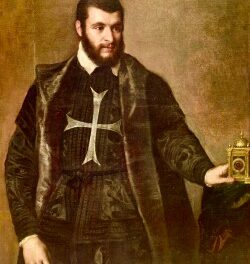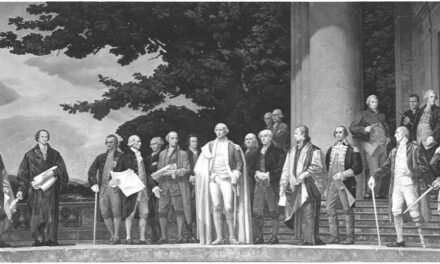We support our Publishers and Content Creators. You can view this story on their website by CLICKING HERE.
Art has the twin functions of reflecting a culture and shaping it. The problem that contemporary artists face is a difficult one: how to express meaning to a world that has become culturally over-stimulated by the spectacular, the hyper-sexualized, and the dumbed-down by inanity, and which has increasingly become antagonistic to manifestations of Christianity.
“We mean all sort of things, I know, by Beauty. But the essential advantage for a poet is not to have a beautiful world with which to deal: it is to be able to see beneath both beauty and ugliness; to see the boredom, and the horror, and the glory.” This quote from T.S. Eliot gladdens my soul.
I have had the opportunity to pull back from my otherwise consuming activities to focus on something altogether different: Beauty. In particular, the intersection of faith, art, and culture where the True, the Good, and the Beautiful take form. The Glen Workshop, sponsored by Image, attracts poets, painters, and playwrights, writers of fiction and filmmakers, illustrators, collage-makers, and musicians from across the continent for a week in Santa Fe to deepen their craft or learn a new one. Many—but not all—are people of faith, wrestling with the calling that accompanies their gifts, struggling to give shape to the collision of the immanent and the transcendent, the irruption of spirit into the material realm, and the journey of the human soul from doubt to belief.
What value can art have in a world so distressed by war, ideological clashes, poverty, economic implosion, moral disintegration, unemployment, and all the other ills that afflict us? John Paul II addressed the value of work—all work—in his encyclical Laborem Exercens:
“When a man works he not only alters things and society, he develops himself as well. He learns much, he cultivates his resources, he goes outside himself and beyond himself. Rightly understood, this kind of growth is of greater than any external riches which can be garnered…. Hence the norm of human activity is this: that in accord with the divine plan and will, it should harmonize with the genuine good of the human race, and allow people as individuals and as members of a society to pursue their total vocation and fulfill it.” (Laborem Exercens, 23)
It is refreshing, and a little surprising for someone who has been so long entrenched in the dissolute realm of poverty and broken down neighborhoods and systems, to discover a gathering of serious souls involved in the hard work of creating beauty. By that I don’t mean the saccharine realm of prettiness, but the difficult kind of beauty incarnate in the suffering Christ and the scandal of the cross.
Art has the twin functions of reflecting a culture and shaping it. The problem that contemporary artists face is a difficult one: how to express meaning to a world that has become culturally over-stimulated by the spectacular, the hyper-sexualized, and the dumbed-down by inanity, and which has increasingly become antagonistic to manifestations of Christianity. Some of the artists who are here this week struggle to believe that the vocation as an artist–especially a Christian artist–has any meaning or value at all. They are at the edge of redefining and creating anew with moral imagination a vision of the True, the Good, and the Beautiful that has been all but exterminated in Western culture.
Something happened at the beginning of the twentieth century in Europe that radically redefined beauty, truth, and order. Between roughly 1905 and 1920 artists in the realms of music, dance, poetry, architecture, and prose inhaled the Zeitgeist at the same time that political order took on the ideological form of totalitarianism. Picasso’s first Cubist painting, “Les Demoiselles d’Avignon” (1907), Schoenberg’s atonal music (1908-1912), Stravinsky’s “Rite of Spring” (1913), Bauhaus architecture (beginning 1919), T.S. Eliot’s “Wasteland” (1921), and Joyce’s Ulysses (1922) all manifest a massive fragmentation, a break with traditional order, which is shattered. In stunning synchronicity, visual, musical, linguistic, architectural, and political order are all cast down, broken into pieces. They were replaced by man-made construction whose intention was no longer beauty and transcendence.
Painting, music, and dance were all radically reshaped in the new modernist order. Picasso jettisoned traditional forms of female beauty for jagged images of prostitutes, tinged with violence and African paganism. Schoenberg disallowed the harmony of the spheres with his atonal works from 1908-1912. In 1912 he had a creative crisis, unable to move forward for nearly decade. In the 1920’s he reappeared with a 12-tone system of his own making. (Which has been the bane of concert-goers since. My husband and I slip out for a glass of champagne rather than suffer.) Stravinsky’s “Rite of Spring”(1913) was inspired by a single visual image that came to him–who knows how–of a virgin dancing herself to death as a pagan sacrifice to fertility gods. Dissonant music of arythmical score taxed instruments beyond their range, and Diaghilev’s angular choreography stretched dancers into contorted positions. When the “Rite of Spring” was first performed, audiences tore up the seats and shouted in protest at the destruction it conveyed.
The literary genre manifested fragmentation in various forms. In Ulysses, James Joyce remakes the English language into a barely penetrable whirl of images and linguistic inventions. T.S. Eliot witnessed the landscape of Europe, still smoking in the ashes of the First World War, crippled with despair and angst, and he rendered what he saw in 1921 in “The Wasteland” with haunting, fragmented images. (Eliot is the one exception among the artists I name: his intentions were not to destroy order, but to reflect the bleak landscape he observed. This was written before his conversion, and may have mirrored his inner landscape as well.) The jaggedness of the poem, originally more narrative, was hewn by Ezra Pound’s vigorous editing, in keeping with the Vorticist Manifesto that Pound and artists like Wyndham Lewis had crafted, celebrating the “whirling vortex,” “suction, whirlpool and matrix,” and art that was “dogmatically anti-real.”
I am fully aware that music, painting, dance, and literature had evoked howls of dismissal in earlier stylistic transitions. But it is striking that almost all of these aggressively excluded God in the new order. There is much more to be said, but suffice it to say that together, these developments remade the face of the arts into their modernist image, definitively rejecting Augustine’s definition of beauty as that which is complete, harmonious, and luminous.
America experienced a similar convergence of cultural cataclysm in the watershed year of 1968. Space does not permit a thorough treatment here of all that was uprooted, discarded, and remade in that year. Any traditional understanding of truth, morality, beauty, faith, and order was jettisoned with astonishing thoroughness in a sweeping revision of the culture. We have still not recovered.
But now, after forty years in the wilderness, here and there are glimmerings of light: Composers who successfully create from a tonal palette of harmony and dissonance and move the listener to understanding and wonder, rather than despair. Architects who are building worship spaces that lead the soul to encounter God with awe. Novelists and poets whose reflections don’t duck the hard questions, but point us toward apprehension of the Permanent Things. Even television and Hollywood scriptwriters, who are infusing their craft with thoughtful reflections on the human condition, working in the belly of the Beast.
These artists are, of course, for the most part marginalized by the Powers That Be, the major national publications, theaters, and galleries of repute. But the numbers of artists in this movement are growing, as evidenced in thirty years’ experience of Christians in the Visual Arts (CIVA), and in over twenty years’ experience of Image, founded by Greg Wolfe (who was my student assistant at Hillsdale College, as I like to remind him). Both are nurturing the present and future generation of artists.
Is culture reshaped from the bottom up or the top down? James Davison Hunter in his book To Change the World asserts that the elites determine the parameters of culture. Of course the elites have the machines to reach millions. But I am not yet convinced that they have the last word. Some thirty-five years ago I witnessed the “Second Culture” created by courageous people under the communist yoke. These thoughtful souls grew in influence as they wrote plays, poems, and novels (think Wojtyla, Solzhenitsyn, Havel, Michnik, Ratushinskaya), even if their works were published as samizdat. These deep thinkers educated willing minds in the ad hoc “Flying University” of Poland and in the living rooms of kindred spirits in East Germany, Czechoslovakia, and Russia. They reclaimed the True, the Good, and the Beautiful for themselves. (Their labors were not for the faint-hearted, however. Only Wojtyla was not imprisoned, but an assassin’s bullet nearly ended his life in St. Peter’s Square.) Despite all attempts by the communists to eradicate faith, these thought leaders found the source of goodness, Love himself, and were given the courage to say so. The elites had the absolute power of totalitarianism, and in the end, they were still not able to withstand this “Second Culture.”
We are in sore need of creating a “Second Culture” in the West. According to T.S. Eliot, the crucial question is whether we can preserve and reclaim culture, resuscitate and rescue it from secularization. He wrote: “Culture may… be described simply as that which makes life worth living…. It is what justifies other peoples and other generations in saying, when they contemplate the remains and the influence of an extinct civilisation, that it was worth while for that civilisation to have existed.” What from current American culture would merit that affirmation?
Can beauty save the world? I don’t know the answer to that question. But I would rather live in a world where honest souls are doing their utmost to create the best and highest art for which their Creator has gifted them, than to abandon the attempt.
This revised essay originally appeared here in August, 2010.
The Imaginative Conservative applies the principle of appreciation to the discussion of culture and politics—we approach dialogue with magnanimity rather than with mere civility. Will you help us remain a refreshing oasis in the increasingly contentious arena of modern discourse? Please consider donating now.
Editor’s Note: The featured image is “The Birth of Venus” (c. 1484–86), by Sandro Botticelli, courtesy of Wikipedia.

 Conservative
Conservative  Search
Search Trending
Trending Current News
Current News 






